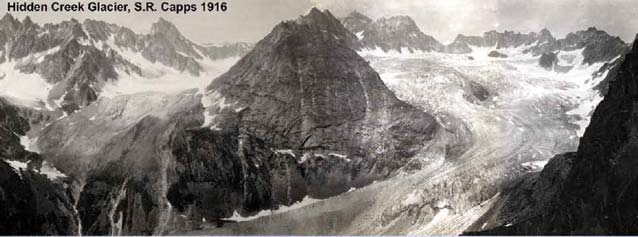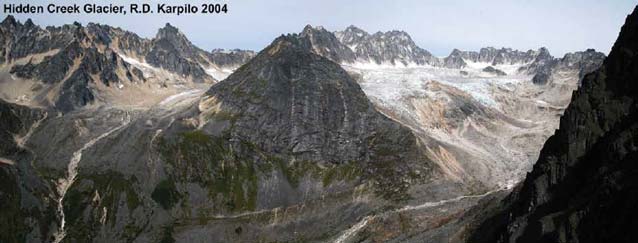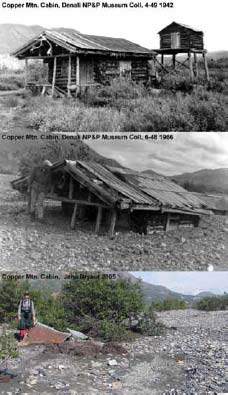Repeat photo pairs provide dramatic visual evidence of recent changes in vegetation, water bodies, and glaciers, among other elements of the landscape. While there are unique natural and cultural history vignettes revealed among this large set of photographs, such as the draining of Bergh Lake, and the burial of the Copper Mountain Cabin by river gravels, the majority of photo pairs show change patterns that appear to be operating on a larger scale.

Stephen Capps and Ron Karpilo

Stephen Capps and Ron Karpilo
In 2005 Denali National Park and Preserve received a donation of many hundreds of photographs taken from the backseat of a two-seater airplane by Dr. Fred Dean, emeritus professor of wildlife biology at the University of Alaska.
Dr. Dean had taken these photographs in the summers of 1975-6 as part of a project to produce the first land-cover map of (then) Mt. McKinley National Park. This treasure trove of images and associated mapped locations documented by immaculate field notes helped launch a major effort to acquire matched sets of repeated historic/modern photo pairs as a way to observe and detect changes occurring across the park landscape: the Denali Repeat Photography project.
The goals of the Denali Repeat Photography project are to acquire, organize, and interpret matched repeated photographs that capture landscape dynamics as they occur across time, and present them in an informative manner accessible to a diverse audience.
To meet these goals, park staff looked far and wide, searching archives and personal collections and working with cooperators including long-time Denali researchers such as Dr. Leslie Viereck to find valuable historical images that would be useful for studying landscape change. Park staff then made numerous trips on foot, by vehicle, or by helicopter to repeat, as closely as possible, the original historical photographs. We also received donations of many high-quality repeated photo-pairs from cooperators such as Ron Karpilo, a geologist who has captured numerous images of glacier change in the park.

Repeat photo pairs provide dramatic visual evidence of recent changes in vegetation, water bodies, and glaciers, among other elements of the landscape. While there are unique natural and cultural history vignettes revealed among this large set of photographs, such as the draining of Bergh Lake, and the burial of the Copper Mountain Cabin by river gravels, the majority of photo pairs show change patterns that appear to be operating on a larger scale.
In fact, the magnitude of observed changes in many of these photo pairs suggests that a significant alteration of the parks ecosystems is occurring in some areas, likely caused by a warming climate and related processes. Some of the primary types of change documented include:
- (1) expansion of spruce into formerly treeless areas,
- (2) invasion of open wetland areas by woody vegetation,
- (3) widespread colonization of formerly open floodplains and terraces by vegetation,
- (4) shrinking ponds, and
- (5) receding glaciers and related features.
In many cases, these changes appear directional; that is, they represent a qualitative shift in the landscape mosaic, not simply a shift in vegetation due to succession or cyclical fluctuations in pond level or glacial extent.
The Denali Repeat Photography project has helped to gather and make available to the public this valuable visual evidence of these important and far-reaching changes that have the potential to significantly affect park resources over the long term.
Part of a series of articles titled Alaska Park Science - Volume 12 Issue 2: Climate Change in Alaska's National Parks.
Last updated: February 5, 2015
